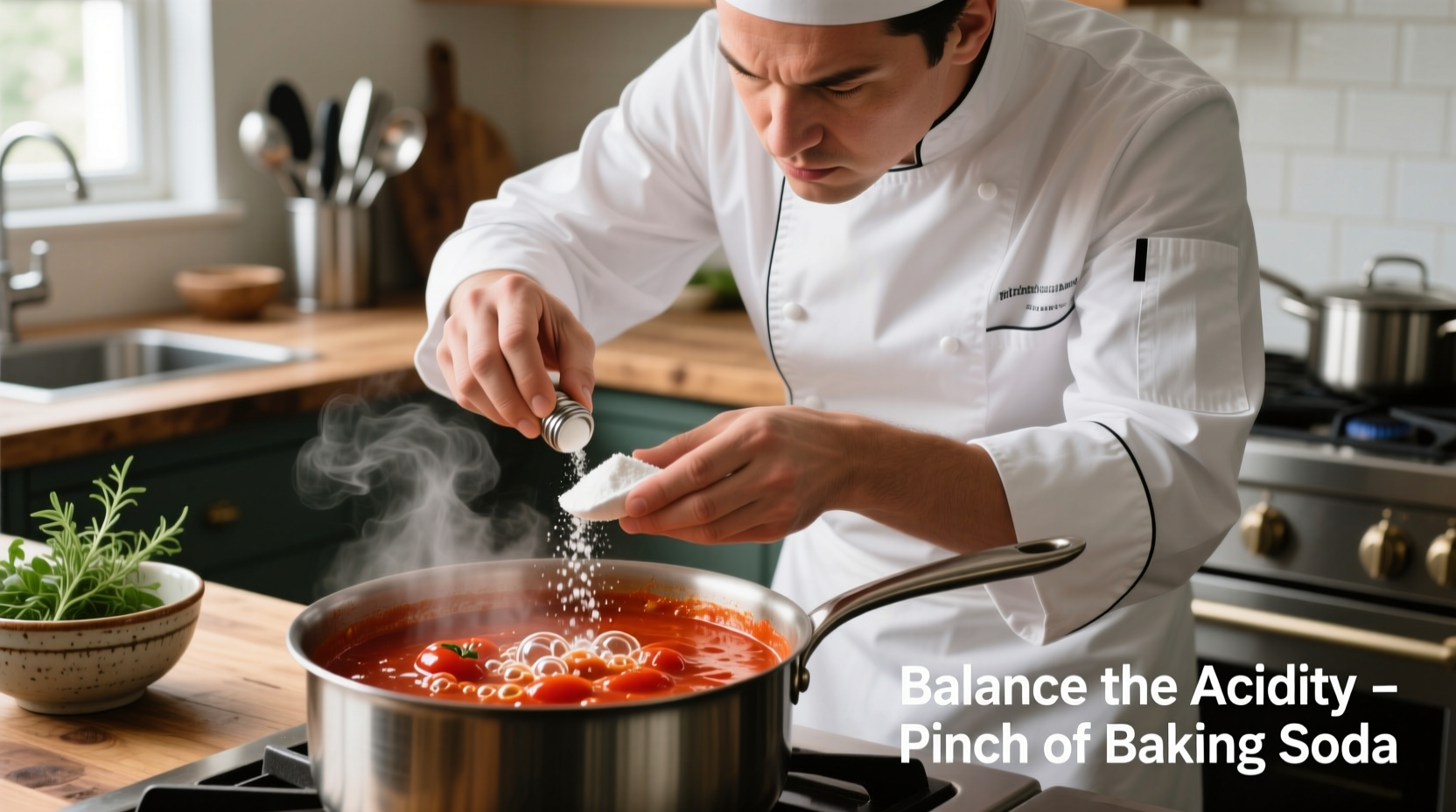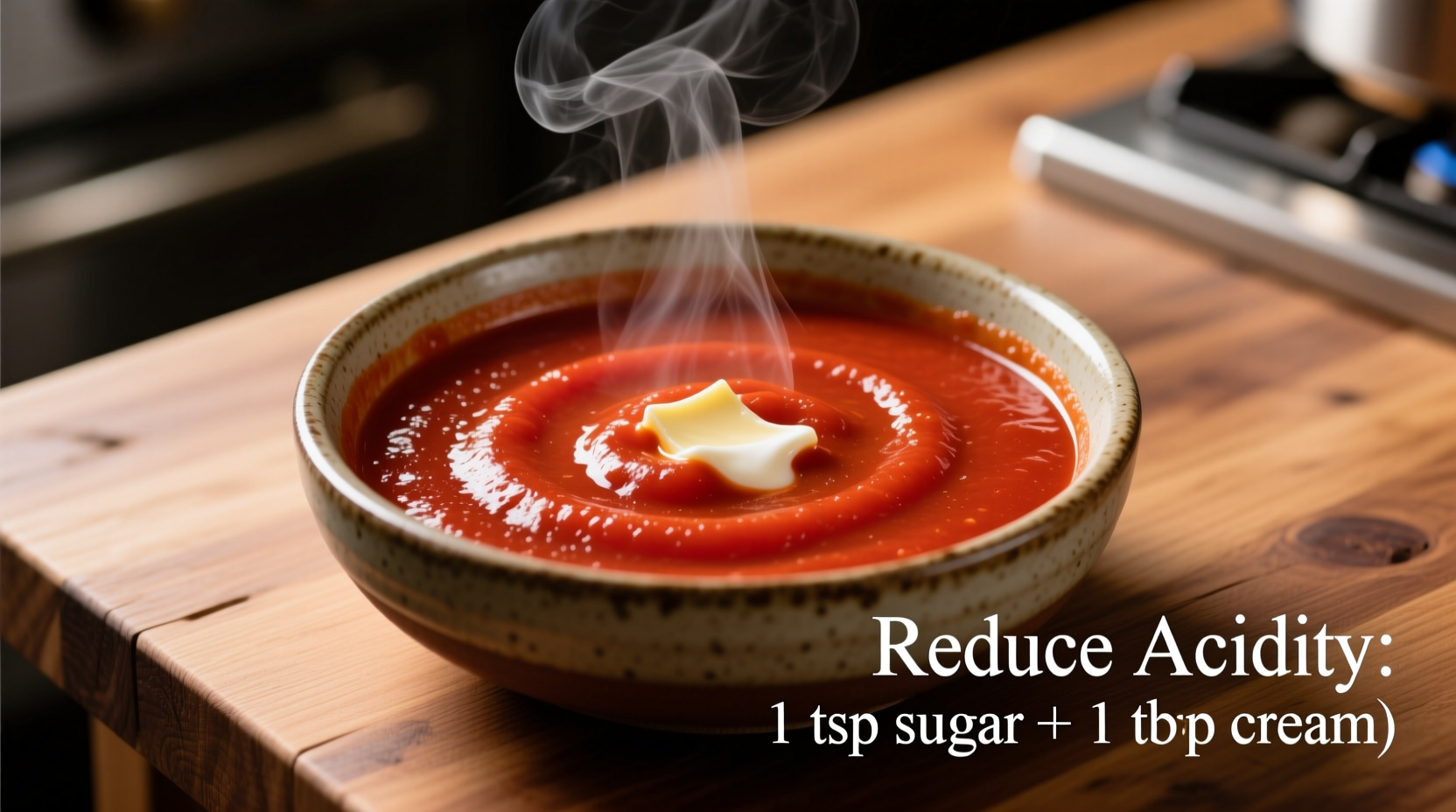Why Your Tomato Sauce Turns Out Too Acidic (And How to Fix It)
Tomato sauce acidity frustrates home cooks worldwide. Understanding why it happens is your first step to perfecting that balanced flavor. Fresh tomatoes naturally range from pH 4.3-4.9, placing them firmly in the acidic category. When reduced during cooking, this concentration intensifies. Certain varieties like Roma pack higher citric acid levels, while extended simmering without balancing ingredients creates that unpleasant sharpness.
Immediate Fixes for Overly Acidic Sauce
When your sauce tastes like battery acid, these proven techniques deliver relief within minutes. The key is understanding which method suits your current cooking stage and desired flavor profile.
Baking Soda: The Quick Neutralizer
Sodium bicarbonate (baking soda) chemically neutralizes acids through an immediate reaction. The USDA's Food Safety and Inspection Service confirms this safe, effective method for pH adjustment in home cooking. Start with 1/8 teaspoon per cup of sauce, whisking thoroughly. Watch for fizzing - this indicates the acid-base reaction occurring. Wait 30 seconds before tasting. Add more in tiny increments only if needed, as excess creates soapy flavors.
Natural Sweeteners: Flavor-Balancing Alternatives
While sugar doesn't reduce actual acidity, it counteracts perception of sourness. The Culinary Institute of America recommends these natural options:
- Grated carrot: Adds subtle sweetness as it cooks down (1/2 medium carrot per cup)
- Finely diced onion: Caramelizes during simmering (1/4 cup per cup of sauce)
- Honey or maple syrup: Use sparingly (1/2 teaspoon per cup) to avoid overpowering
| Method | Time Required | pH Change | Flavor Impact | Best For |
|---|---|---|---|---|
| Baking soda | Immediate | Significant | Neutral | Emergency fixes |
| Grated carrot | 15-20 minutes | Moderate | Natural sweetness | Long simmers |
| Butter | 2-3 minutes | Minimal | Richness | Finishing touch |
| Sugar | Immediate | None | Sweet | Quick balance |
Preventing Acidity During Cooking
Professional chefs at the James Beard Foundation recommend building balanced flavor from the start. Add these ingredients during your sauce preparation:
Strategic Ingredient Timing
Adding balancing elements at specific cooking stages creates optimal results. Food science research from the University of California Davis shows that carrots added in the first 15 minutes of simmering release maximum natural sugars through caramelization. Onions should hit the pan before tomatoes to develop their sweetness. Finish with a tablespoon of butter off-heat for that restaurant-quality mouthfeel that masks acidity perception.
Tomato Selection Matters
Not all tomatoes behave the same. San Marzano varieties naturally contain lower acid levels. The USDA Agricultural Research Service confirms that ripe, vine-ripened tomatoes have 20-30% less acidity than underripe counterparts. When using canned tomatoes, check labels for "calcium chloride" - this firming agent increases perceived acidity.

Troubleshooting Common Problems
Even with proper technique, issues arise. Here's how to handle them:
Sauce Still Too Acidic After Treatment
If your sauce remains sharp after initial adjustments, you've likely under-neutralized. Add another 1/16 teaspoon baking soda per cup, whisking thoroughly. Wait five minutes before retesting - chemical reactions need time to complete. Never add more than 1/4 teaspoon total per cup to avoid metallic aftertastes.
Context Boundaries: When Methods Fail
Understanding limitations prevents kitchen disasters. Baking soda works only in liquid environments - don't use it on raw tomatoes. Sugar becomes cloying in meat-based sauces. Butter separates in high-acid environments. The American Chemical Society notes that pH adjustments beyond 0.5 units typically require professional equipment. For severely unbalanced commercial products, start over rather than over-correcting.
Accidentally Over-Neutralized Sauce
Too much baking soda creates flat, soapy flavors. Fix this by adding small amounts of acid - a teaspoon of tomato paste or lemon juice per cup. Simmer for five minutes to integrate. If using sugar-based methods, excessive sweetness requires dilution with additional tomato product rather than adding more acid.
Mastering Tomato Sauce pH Balance
Consistent results come from understanding the science. The ideal finished sauce pH ranges between 4.6-4.9. Use pH test strips (available at brewing supply stores) for precision. Remember that cooling changes perceived acidity - always taste sauce at serving temperature. For meal prep, slightly under-correct acidity since it diminishes during storage.
Frequently Asked Questions
Can I use baking powder instead of baking soda to reduce acidity?
No. Baking powder contains acidifying agents that counteract its neutralizing effect. Stick with pure baking soda for acid reduction.
Why does my tomato sauce get more acidic as it cooks?
As water evaporates during simmering, acid compounds concentrate. This intensifies the tart flavor while reducing volume.
Does adding olive oil reduce tomato sauce acidity?
Olive oil doesn't change pH levels but creates a protective barrier on your tongue that reduces acid perception. Use as a finishing oil rather than cooking fat for best results.
How can I tell if my sauce is properly balanced without tasting?
Watch for visual cues: properly balanced sauce coats the back of a spoon evenly. Overly acidic sauce appears watery and separates from oils.
Can I freeze tomato sauce after adjusting its acidity?
Yes, but note that freezing can slightly increase perceived acidity upon thawing. Under-correct by about 10% before freezing to compensate.











 浙公网安备
33010002000092号
浙公网安备
33010002000092号 浙B2-20120091-4
浙B2-20120091-4